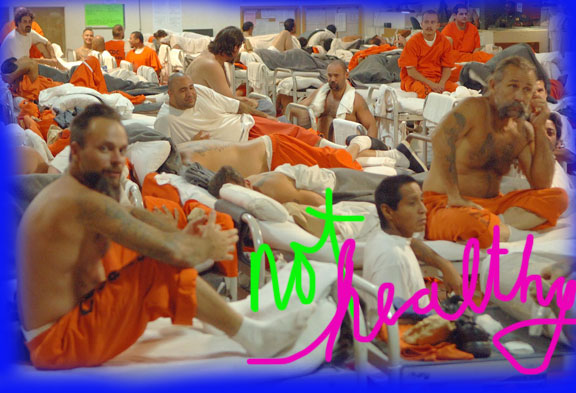Tuesday the U.S. Supreme Court heard the much anticipated arguments on the case that will decide whether a very fed up three-judge panel has the authority to order California officials to lower the state’s prison population by 30,000 or 40,000 inmates—as the panel did early last year.
Those of us reading tea leaves based on the nature of the questions asked by the 9 justices, think that the Supreme just might let the judges’ ruling stand.
In case you haven’t read any of my natterings on the matter over the past three years, here is a bit of back story on the case from a well-written article in USA today.
The case, drawing broad interest from public health and psychiatric health groups, civil libertarians and law enforcement, brings to the fore the power of U.S. judges to intervene in social problems that are traditionally the domain of elected state officials.
California officials, backed by 18 states, are appealing an order by a special three-judge U.S. district court that would require the state to reduce prison overcrowding significantly to improve conditions. California says the court order could mean the release of about 40,000 inmates to the streets.
The three-judge panel said earlier measures, including those aimed at increasing staff and improving care, had failed to improve the system sufficiently. The judges concluded that overcrowding was the primary cause of the health problems and ordered the state to get the system down to 137.5% of prison capacity over the next two years.
The order came in a pair of class-action lawsuits challenging mental health and medical conditions, one that began in 1990, the other 2001.
Prisoners’ lawyers describe horrific conditions in their filings, saying that “mentally ill prisoners have been found hanged to death in holding tanks where observation windows are obscured with smeared feces, and discovered catatonic in pools of their own urine after spending nights in locked cages.” They stress that such conditions have been ongoing.
In decades past, federal judges often got involved to speed school desegregation, solve environmental problems and remedy conditions in mental health facilities and prisons. That era has faded for many reasons, including that the increasingly conservative Supreme Court has reversed lower court judges who delved in recent decades into social needs.
If the order is upheld, the state has two years to reduce the prison population by the required 40,000-ish inmates. This does ncontrary to the knee-jerk characterization of the problem— mean simply dumping 40,000 inmates on to the streets. But that kind of population reduction will take some meaningful changes in policy—among them, further overhauls in parole policy, more transfers of prisoners to out of state facilities and, frankly, an new look at sentencing. And, yes, there will also likely be some prisoners getting out a bit early for “good time” behavior, meaning that they have participated in rehabilitative programs.
As the Supremes asked questions of the two groups of lawyers, the four liberal justices seemed clear in their leanings toward letting the 3-judge ruling stand. Justice Roberts and Alito seem especially prone to overturn the panel’s demand.
As is usual, however, it was Justice Kennedy—the swing vote—whom everyone watched.
Kennedy asked sharp questions of both the inmates’ lawyer and of the state’s attorneys. But then all at once Kennedy said with exasperation, “At some point the court has to say: You have been given enough time. The constitutional violation still persists, as the state itself acknowledges.”
It was hard not to see the remark as telling.
A ruling is expected in June 2011.
POST SCRIPT: Before SCOTUS rules, of course, California will have a new top cop, namely the AG-elect, Kamala Harris. With this in mind, it is interesting to note (as the Sac Bee does) some lines from her book, “Smart on Crime,” in which Harris describes the larger human cost of the state’s ever-ballooning prison population, particularly to nonviolent offenders who just get further broken by the hideously dysfunctional system:
“For several decades, the passage of tough laws and long sentences has created an illusion in the public’s mind that public safety is best served when we treat all offenders pretty much the same way: arrest, convict, imprison, parole. …
“What the numbers say loud and clear, however, is that most nonviolent offenders are learning the wrong lesson … are becoming better and more hardened criminals during their prison stays.”
Photo courtesy of the California Department of Corrections and Rehabilitation, taken at the California Institution for Men, at Chino, August 7, 2006.
(Weirdly enough, as I was doing my usual scribbles, I noticed that I know someone in this photo. He’s the bald guy at the upper center who is sort of lounging on one elbow. Once a hard core gang member, he’s out of prison now and doing phenomenally well, a truly excellent man who found himself belatedly with the help of others who told him he was worth something—no thanks to the CDCR, which needs to drop the “R” from its title, or start living up to it.)


I will be posting later tonight about the draconian prison industrial complex and the CCPOA. Let’s hope this doesn’t invoke the usual vitriol.
This guy look harmless huh? This is the type of guy all you lefties are ok with being treated in the manner the D.A.’s office did. Harris would have probably taken him home and made him dinner.
http://www.latimes.com/news/local/la-me-12-1-home-invasions-20101201,0,5112943.story
Dick Cheney and Bush Sr. would have given him billions to defeat all of his gang rivals with communist ties.